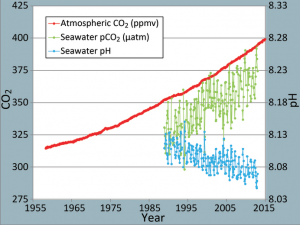In this second portion of my research paper i examine the causes of ocean acidification, as well i discuss internal government policy as well as how home living has lead to this issue.
“What is the major cause behind potentially the biggest threat to the human race, research suggests the answer is simple, humans. The data suggests that Co2 concentrations in the atmosphere are closely linked to marine co2 levels, meaning that since data began being collected in the 20th century the levels of marine Co2 have steadily increased along with atmospheric levels. Along with that there has been a steady decrease in ocean Ph levels showing a clear correlation between ocean acidification and the amount of Co2 released into the atmosphere and subsequently absorbed into the ocean.

This graph plots the Co2 in the land and ocean along with the Oceans PH
This shows that just like atmospheric Co2 Ocean Co2 is directly linked to human activities. Things like energy production (Ie. Coal burning), driving vehicles run by petrol or any other form of human activity that leads to a release of co2 into the atmosphere is also directly increasing the levels of Co2 in the ocean. Scientist originally believed oceans to be un touchable, too large for us to possibly have any sort of meaningful impact on, and as the earth largest Carbon sink (the ocean absorbs about a quarter of the Co2 released into the atmosphere according to the NOAA) scientist believed it might be our best chance at staving off global warming hoping that if given time the ocean would be able to clean out the atmosphere of the dangerous amount of Co2 in the atmosphere. But as we have seen so many times before scientist were not seeing the whole picture, discoveries were made in the mid to late 20th century that indicated that in fact oceans were not immune to the unstoppable force that seems to be human innate ability to destroy all that is around it.
Scientist now realise that ocean acidification is a very real and very threatening issue, and many objectives have been set out to look for any sort of solution, as well as infrastructure has begun being put in place as to better be able to collect data throughout the oceans. The National Oceanic and Atmospheric Administration (NOAA) based out of the United States has begun setting up missions to have Coordinated carbon Observing networks along all of the United States of Americas oceanic boundaries as well as the open oceans which currently have very little in terms of data collection possibilities at all. Currently the group relies on “repeat hydrographical surveys, time-series stations and ship-based underwave surface observations in the open ocean” according to the NOAA’s official website the current method is not a bad foundation on which to form data and the website goes on to explain that most of what we know today about this subject has been derived from process’s similar if not identical to those they are doing at the present time. But the NOAA just like the rest of the scientific community understands how much of an issue ocean acidification is and that for them to properly combat the issue they must have consistent proper data, and the best way to achieve that goal is to have improved methods for gathering it. In its mission statement the NOAA says it plans to expand global moored and ship based networks by adding Ph and biochemical measurements. With these new measurements the new information that would be gathered about ocean acidification would be hugely important to the scientific study of the subject and would allow scientists to grasp a better understanding of carbon distribution and variability throughout the world’s oceans on both a time and latitudinal basis. This new information would allow scientists to create new models that are more accurate, therefore allowing for a greater understanding of how carbon immersions will shape marine ecosystems for centuries to come. This new information would solve a very important gap in the knowledge we currently have about ocean acidification giving scientist a deeper understanding of carbon throughout the oceans and how it concentrates its self. Carbon is just like in the atmosphere not distributed evenly throughout the ocean and with no single network gathering information currently but rather individual organisations doing separate mission our understanding of carbon fluidity in the ocean as a whole has been a challenge. The NOAA however has taken on a project to set up permanent gathering stations along the north American east and west coasts to gather data on carbon fluidity as to gain a better understanding of how carbon surplus’s move throughout the oceans. The importance of this information is that carbon fluidity and variance is very volatile, carbon levels in water can change on scales from as short as hours to as long as decades due to rivers, tides, photosynthesis and ground groundwater inputs. Gaining an understanding of how carbon flows through these areas of coastal land would allow scientists to identify areas that are at the most risk currently and understand where the largest concentrations of carbon in the oceans are coming from with the hope of a possibility of stopping its clumping in specific areas in the ocean. If implemented these new methods will allow the scientific community to have better access to necessary data that may allow them to solve the problem before it is too late.”
The third and final part can be found in my final post.

OMG. I totally agree with your beliefs on acidification! This is the best blog post ever. I teared up when you talked about the Carbon sink! Who knew?? I would love to get in contact with you to pick your brain more